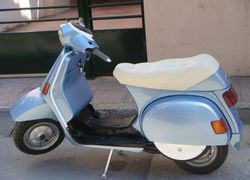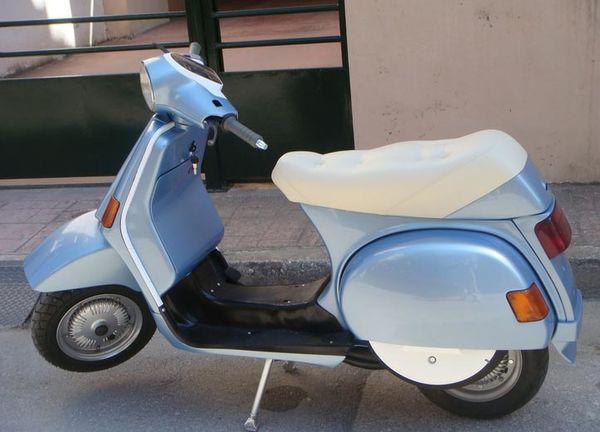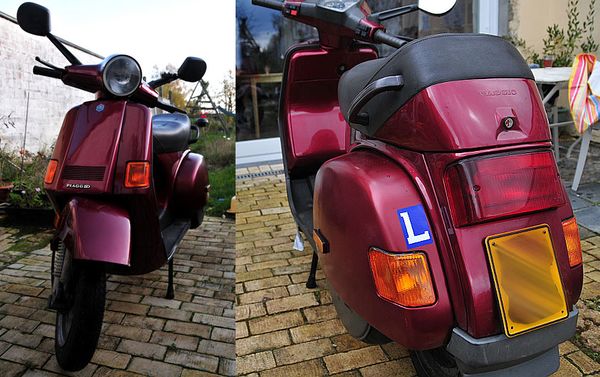Vespa 200 Cosa
 |
|
| Vespa 200 Cosa | |
| Manufacturer | |
|---|---|
| Production | 1988 - 92 |
| Engine | Four stroke, single cylinder, horisontal cylinder |
| Compression ratio | 8.8:1 |
| Top Speed | 95 km/h / 59 mph |
| Ignition | Electronic |
| Spark Plug | NGK B9ES |
| Battery | 6V |
| Transmission | 4 Speed, grip-shift, constant mesh |
| Frame | Pressed sheet steel, streamlined monocoque structure |
| Suspension | Front: Coil spring with hydraulic shock absorber, double effect Rear: Coil spring with hydraulic shock absorber, double effect |
| Brakes | Front: Drum, expanding type Rear: Drum, expanding type |
| Front Tire | 100/90-10 |
| Rear Tire | 100/90/10 |
| Wheelbase | 1270 mm / 50 in |
| Weight | 103 kg / 227 lbs (dry), |
| Fuel Capacity | 7.0 L / 1.85 US gal |
| Manuals | Service Manual |
It could reach a top speed of 95 km/h / 59 mph.
Engine[edit | edit source]
The engine was a Air cooled, forced cooled Four stroke, single cylinder, horisontal cylinder. The engine featured a 8.8:1 compression ratio.
Drive[edit | edit source]
Power was moderated via the Wet, multiplate.
Chassis[edit | edit source]
It came with a 100/90-10 front tire and a 100/90/10 rear tire. Stopping was achieved via Drum, expanding type in the front and a Drum, expanding type in the rear. The front suspension was a Coil spring with hydraulic shock absorber, double effect while the rear was equipped with a Coil spring with hydraulic shock absorber, double effect. The 200 Cosa was fitted with a 7.0 L / 1.85 US gal fuel tank. The bike weighed just 103 kg / 227 lbs. The wheelbase was 1270 mm / 50 in long.
Photos[edit | edit source]
Overview[edit | edit source]
The Vespa Cosa was initially to be called the Vespa R (standing for Rinnovata, meaning "revised"). It was unveiled at the Milan Motorcycle Show in 1987. The Cosa is a direct successor to the Vespa PX series, and although the internal workings are largely similar, it came with newly developed gearbox that was a significant improvement upon the gearbox that had previously been used in the PX series. The PX series was still in production at the time, however, and has continued production even after Cosa production was discontinued. Other improvements upon the PX series included storage space beneath the seat and anti-lock brakes on the front wheel. More controversially, it was also the first Vespa to utilise a significant amount of plastic parts in addition to the traditional monocoque pressed steel frame.
The series is broadly divided into two generations. The first generation was built from 1988 to 1991, while the second generation (sometimes referred to as the Cosa FL) was in production from 1992 onwards. Both version are fundamentally the same, with some minor differences. Firstly, the clutch was modified so that it would be easier to pull in and release. Secondly, minor design alterations were made: the tail light was slightly different and moved to a new position, the seat lock was installed on the side of the saddle, and the saddle was widened for extra comfort.
Technical Information While the engine is virtually identical to that of the Vespa PX series of the time, there are three major differences in the design:
The swingarm pivot on the Cosa is wider than that of the PX.
The rear spring strut on the engine housing is shaped differently. This is
because the rear suspension of Cosa is longer than that of the PX.
The mounting for the rear brake is different due to the hydraulic rear
brake.
In addition, the carburetor on the Vespa Cosa came stock fitted with an electronic fuel valve and automatic choke. It also had a digital tachometer (similar to that on later versions of the Vespa T5).
| Make Model | Vespa 200 Cosa |
|---|---|
| Year | 1988 - 92 |
| Engine Type | Four stroke, single cylinder, horisontal cylinder |
| Displacement | 198 cc / 12 cub in |
| Bore X Stroke | 66.5 x 57 mm |
| Compression | 8.8:1 |
| Cooling System | Air cooled, forced |
| Fuel Mixture | 1:50 |
| Ignition | Electronic |
| Starting | Kick start |
| Battery | 6V |
| Spark Plug | NGK B9ES |
| Clutch | Wet, multiplate |
| Max Power | 7.4 kW / 10 hp @ 5000 rpm |
| Transmission | 4 Speed, grip-shift, constant mesh |
| Gear Ratios | 1st 13.42 / 2nd 9.13 / 3rd 6.32 / 4th 4.71:1 |
| Final Drive | Direct drive |
| Frame | Pressed sheet steel, streamlined monocoque structure |
| Front Suspension | Coil spring with hydraulic shock absorber, double effect |
| Rear Suspension | Coil spring with hydraulic shock absorber, double effect |
| Front Brakes | Drum, expanding type |
| Rear Brakes | Drum, expanding type |
| Wheels | Interchangeable, split rim |
| Front Wheel | 3.5 x 10" |
| Rear Wheel | 3.5 x 10" |
| Front Tire | 100/90-10 |
| Rear Tire | 100/90/10 |
| Dimensions | Length: 1800 mm / 70.9 in Width: 836 mm / 32.9 in Height 1210 mm / 47.6 in |
| Wheelbase | 1270 mm / 50 in |
| Ground Clearance | 150 mm / 5.9 in |
| Dry Weight | 103 kg / 227 lbs |
| Fuel Capacity | 7.0 L / 1.85 US gal |
| Consumption Average | 3 L/100 km / 33 km/l / 78 US mpg |
| Top Speed | 95 km/h / 59 mph |

